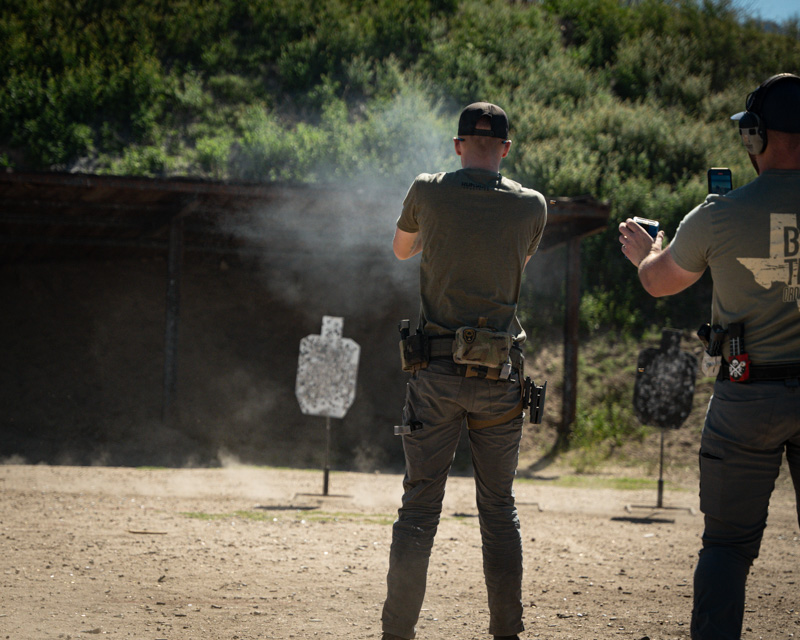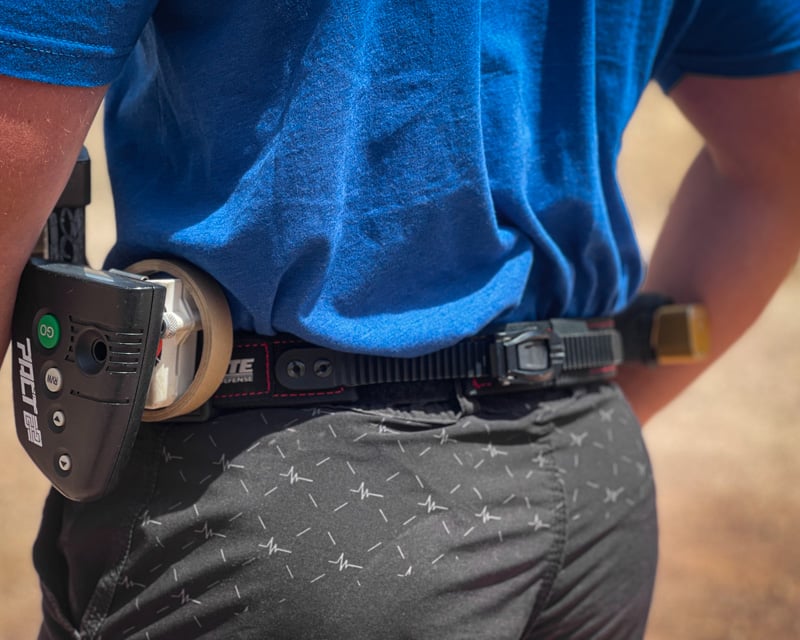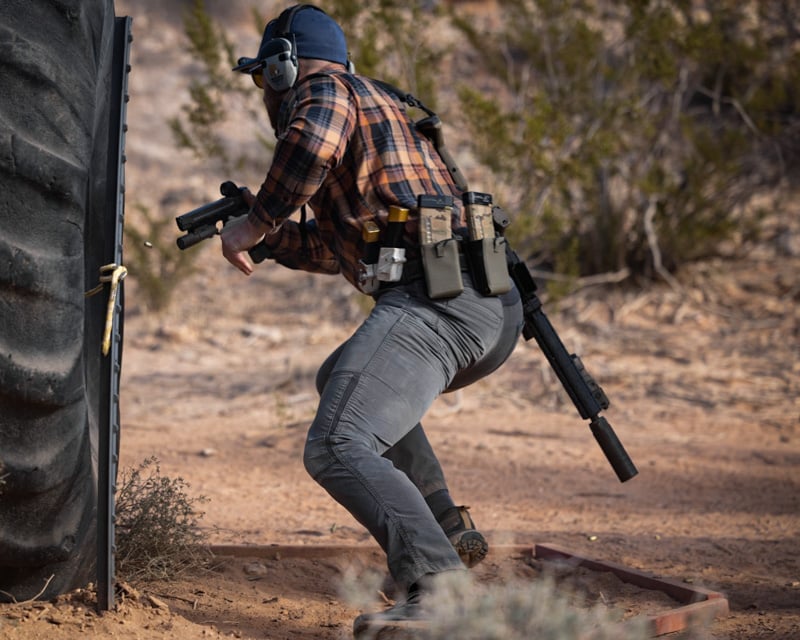If you are interested in competition shooting, one of the first questions you might have is what an optimized belt setup looks like. There is no end-all, be-all set up for a competition belt, but there is equipment that will benefit you based on what competition discipline you are shooting. This article will tackle some of the best belts for different disciplines and the equipment you can have attached. We will talk about these different belts and some gear options. The one commonality between these belts is that they are purpose-built.

USPSA Belt:
A USPSA belt typically consists of two pieces: an inner belt, and an outer belt. The outer belt will be reinforced and rigid to hold all of your magazines and firearm securely. You want to ensure enough space for at least three magazine pouches and one holster. For some divisions like production and single stack, you may need up to six or seven magazine pouches.
PCSL/ Multigun Belt
A PCSL belt needs to consist of everything a USPSA belt has but with the addition of rifle magazine pouches. Since PCSL utilizes two firearms, you must be sure to feed both. I like to use universal magazine pouches, so I have more versatility between the firearms I use. Another consideration is that you may want a pistol holster that has retention during strenuous stages. Some multi-gun matches require physical activities like climbing obstacles or carrying weighted objects.
IDPA Belt
I use my concealed carry belt since IDPA allows an appendix in the waistband holsters, and concealment is required. This makes things easy because I have to change nothing from when I show up to the range to when I shoot the match. Realistically, most shooters use a rigid belt with a holster directly connected to the belt and two magazine pouches.
How do you know what is legal for each discipline?
The best place to find them is in the rule book for each discipline. USPSA will have different requirements for different divisions, so it is essential to see what is best for the gun you’re shooting. Open division will be more relaxed than carry optics, etc. One major rule for USPSA is that no leg straps are allowed in any division.
In PCSL, leg straps are allowed, and the requirements for gear are a lot more relaxed. You are good to go as long as your equipment stays on your person. So you can use “race” holsters, any height drop connectors, plate carriers, and chest rigs. One of the most remarkable aspects of PCSL is they allow cops to use their entire duty setups without change. This provides an excellent environment for law enforcement to test the gear they use daily to protect and serve.
Here are links to each of these disciplines’ rule books:
- PCSL (Practical Competition Shooting Legue)
- USPSA (United States Practical Shooting Association)
- IDPA (International Defensive Pistol Association)

Gear Placement:
I frequently get asked where everything should be mounted on the belt, and no end-all arrangement will work for everyone. Some general placements will help with your proficiency in handling your firearm. Still, it will ultimately fall on the end user to set it specifically for their preferences, division, and discipline requirements.
Generally speaking, your holster should be on your strong side hip. This is typically between the 2 o’clock and 4 o’clock positions. The magazine pouches should go on the opposite hip and, depending on the discipline, between the 12 o’clock and 4 o’clock position on the belt. I find right in front of my weak side hip is my ideal position. I use this between all disciplines, making for a consistent reload no matter what I shoot.
Some other gear to be mentioned are tourniquets and IFAKS. I like to keep those at my 6 o’clock on the small of my back. Using them is not common, but having medical equipment when dealing with firearms is always a good idea. The small of your back keeps them out of the way for sporting purposes but allows you to keep them on your person rather than needing to find them in your range bag.
My final thought on gear placement is how the magazines should be oriented. Again, this comes down to preference, but you will see most high-level competition shooters running their magazines the same way. For pistol mags, it is common to see bullets facing forward or outwards. This makes you reload more efficiently, so you can grab and jam without having to position your wrist weirdly or flipping the mag during the reload. For rifle mags, you want the bullets facing backward for the same reason. How your mags are oriented comes down to how you perform your reload and what you have practiced. This is simply how I like to have my magazines because it’s what I know and what I am used to.

Gear Selection
I will break down my top three recommendations for each gear category.
Belts
Dominate Defense Mach 1: This is my top choice for a competition belt. They are hand-built right here in the United States by hand and are custom-made to fit your waist. This belt offers some of the best rigidity on the market. It utilizes a ratchet system which allows you to get a perfect fit every time.
Double Alpha Lynx Belt: This is a modular poly belt that is great for travel. It packs up small and tight to fit it in your luggage. It’s lightweight but has the drawback of being limited by the plastic panels for sizing. The good news is you can add and subtract links at any time.
Shooters Connection Ultimate Competition Belt: This budget-friendly option is very common with shooters. If you’re getting your feet wet, this is your option.

Hangers
Henning T-1000: This is the best option on the market. It is made from aluminum and has adjustments for every angle of your holster. I currently run this on all my belts. The customization is unmatched and ships with the tools needed to adjust it, which is a huge bonus.
BOSS Hanger: This offers a variety of mounting holes for common holsters on the market. This hanger has a lof adjustment vertically but is limited on the cant angle. The plate’s added length and rigidity help eliminate the common holster flop on factory hangers.
Holsters
Carey Concealment X1 Raptor: This is becoming a popular holster for USPSA. This holster allows for lightening fast draws with a unique retention system. It utilizes a magnet at the barrel end of the holster to keep your pistol in place. This is designed to decrease and possibly eliminate the muzzle flip of your holster when drawing.
Ghost Civilian 3G Elite: This holster is Lined inside with Ledra to protect the gun’s finish. It is common amongst 3-Gunners for its precision retention. The Ledra also has less friction than traditional Kydex, so you will have a smooth and consistent draw.
Magazine Carriers:
Henning T-900: The fastest, most exciting new magazine pouch on the market. Utilizing two 15/20lb magnets, this innovative new magazine pouch gives you full access to your magazine for lightning-fast reloads! The side walls protect the magazine from side bumps, and the magazine sits very securely in the pouch yet is accessible for a direct pull-out grab.
CR Speed Versa Pouch: Multi Mag Fit & Ambidextrous the Versa-Pouch is unlike any other Mag Pouch on the Market, supplied with Inserts that can be added or removed to fit a variety of popular pistol magazines. The Versa-Pouch is also supplied with a large retention adjuster knob, which allows you to make fast & easy retention adjustments.
Haley Strategic Single Mag Pouch: This is what I use for Multigun matches. The Single Pistol Mag Pouch was designed to meet law enforcement and military contract requirements for retention of standard-issue handgun magazines. The elastic retention system is lined with anti-slip polyester knitting and includes shock cord pull tabs enabling adaptability to a wide variety of single-stack and double-stack handgun magazines, multi-tools, flashlights, and other similar-sized items.

Conclusion:
This wraps up the competition belt overview. We covered what different shooting disciplines require, the type of equipment for each shooting style, and some recommendations for you to try at home. I always recommend people use their existing gear before they go out and buy new equipment. Most local clubs will understand your interest in getting into the sport. Once you find what you like, start buying gear that will help your match!


